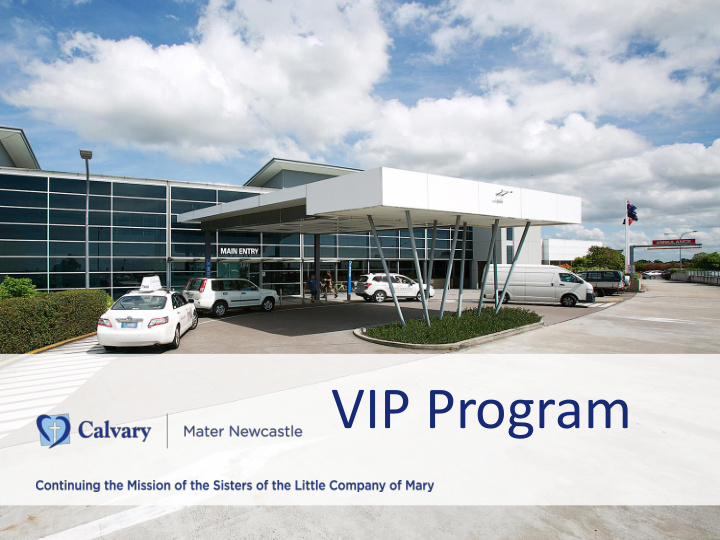



VIP Program
THE V.I.P. Program Reducing presentations to hospital by identifying & addressing the social determinants of health.
Who is a Very Intensive Patient? = Patient representing to ED ≥ 8 times in 12 months = Patient readmitted to hospital ≥ 4 times in 12 months
VIP Model of Care
What is the problem? Staff / Patient Surveys & Interviews
The NEW Patient Journey 8) VIP follow-up 1) Identified as a VIP & monitoring - SCALE-UP Score - Alert on CAP 6) VIP Action plan Personalised care plan for 2) VIP Care Coordinator hospital & community Case management & care coordination 7) VIP Case Conference Meet the patient, carers clinicians & services 3) Make contact with his GP 6) Pharmacist Review Medication reconciliation 4) Senior Medical input contact with local chemist Reviewed 1 st by a 5) Collaborate with other services: consultant in ED/ward NSW Ambulance, Home care, D&A, OT, Physio, Mental health, Palliative Care, Connecting Care
Key Changes Implemented 1. Patient Flow Portal to identify frequency of readmission 2. “Scale - up tool” to explore history and meet with person to ask - What bought you back to hospital ? - What can we do to help you stay well at home ? - What matters to you? 3. Social Workers involvement from the beginning 4. Focus on social determinants of health factors which impact on patients goals of care and the ability to remain at home . 5. Actively involve patient and their family in goals of care 6. “Patient Care Boards” to promote communication 7. NSW Ambulance actively involved
Gender 2016-18 Female male blank 13% 39% 48%
Age VIP’s 2016 -18 140 120 100 80 Axis Title 60 40 20 0 18-25 26-40 41-60 61-75 76-85 86-90 blank Series1 4 11 78 103 132 82 3
Scale up tool results 2016-18 0 50 100 150 200 250 300 350 400 Umemployed 200 Transport 33 Iliterate 2 Non-English speaking 7 Lives alone 141 Aboriginal 33 Homeless 5 Co-morbidities score as per scale up tool 364 Palliative 4 Depression and anxiety 101 Bipolar and schizophrenia 19 Trauma 2 Self harm and borderline personality 10 Drug/ETOH 46 Dementia 28 Hoarding 0
Readmitted within 28 days 2016-18 yes No 1% 99%
ED presentations within 6 months 2016-18 120 100 80 60 Total VIPS presentations 40 20 0 1 ED Presentations 2 ED Presentations 3 ED Presentations 4 ED Presentations 5 ED Presentations 6 ED Presentations 7 ED Presentations Series1 47 58 80 60 117 1 1
Lessons Learnt • The most important step are to identify VIPs and ask them what bought you back to hospital and what matters to you ? • Engage the patient in goals of care that they identify as important to them. • Work with medical teams around the patients goals of care verses goals of treatment . • Assist the family and patient to engage with available social support networks and community services • To sustain your program include the Executive on the journey • For more information Contact: Sandra McKendry or Geraldine Hanlon ph:43817
Acknowledgements and Thank you • Roslyn Barker • Maryann Ferreux • Sarah Scudds • Clinton Starrett • NSW Ambulance • Dianne Holmes • Dr Michael Hayes and Medical Department at CMN
Recommend
More recommend